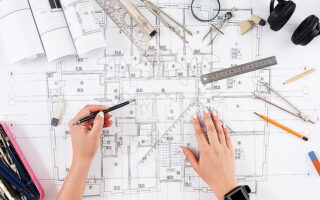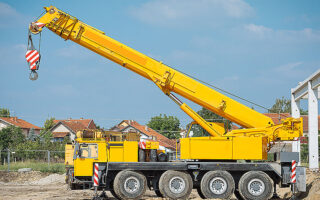The construction industry is a huge world on its own with bridges, skyscrapers, buildings, malls, and other commercial and private projects going on. These projects cannot be carried out without cranes that help move, shift, load, and unload extremely heavy materials and weights. However, as there are many types with their specific functions and weight capacities, it can difficult to choose the right ones from crane rental services for your project. We will list down the most common types of construction cranes for you to consider.
Tower Cranes
Tower cranes are the most popular types of cranes used in construction. These cranes are easily identifiable based on their massive size and height. In most cases, you are going to see tower cranes in the middle of the construction area as they can turn 360 degrees to shift, load, and unload heavy weights.
As the term suggests, tower cranes consist of a mast, a jib, and a tower. Tower cranes can reach extreme lengths and heights when it comes to shifting heavy loads. At the same time, tower cranes can only be transported to the site. These cranes require just one operator who sits in the cabin and performs the lifting and shifting tasks.
Because tower cranes cannot be driven, they need to be assembled and disassembled before transporting and after reaching the destination. This makes these cranes slightly more expensive than other types due to more labor hours required.
However, tower cranes are known for lifting extremely heavy weights. Some tower cranes have managed to hold a record weight. So, if you are looking to rent a tower crane, you need to define your needs and preferences first. These cranes will do the job for you but not if you don’t have the space or plan on lifting heavy weights.
Hammerhead Cranes
Hammerhead cranes look like a huge upside-down L. The difference here is that the jib can rotate but cannot be lowered or raised. This model is most commonly found in construction areas where several cranes are operating at various levels. Plus, hammerhead cranes are mostly used in areas that have limited space.
This means these cranes can also be used inside a structure or in particularly tight spaces. Hammerhead cranes feature an A-frame which is a metal structure connecting the cables from the jib to the counter jib. This allows the crane to lift extremely heavy weights.
Floating Crane
Floating cranes are mostly used for projects at sea, oil rigs, or ports. These cranes are not so popular when it comes to construction projects on land as the term suggests. Floating cranes have been around for ages and have gone through extensive technological advancement to reach where they are today.
Today, you have several types of floating cranes available such as the sheerleg and semi-submersible. However, then again, the term floating crane is used for cranes used at sea. So, unless you have an oil rig or want to build one, floating cranes won’t be of much use to you.
Truck Mounted Cranes
Truck-mounted cranes are amongst the most popular construction cranes out there. This is why you can find crane truck rentals VA easily. These cranes are found at almost every single construction site. Truck-mounted cranes as the term suggests are cranes mounted on trucks that can be easily driven around or transported.
Truck-mounted cranes come with wheels that allow them to be driven on highways. The best thing about truck-mounted cranes is that they can easily access different areas and due to their compact and robust size can easily maneuver in tight areas or spaces.
However, these cranes when compared to others can’t lift very heavy loads. At most, these cranes will lift and shift concrete blocks and stuff. But, if you wish to manage extremely heavy items, you will need a bigger crane.
Crawler Crane
Crawler cranes have tracks. These cranes do not feature wheels like the other crane types. Instead, these cranes use a pair of undercarriage-fitted rubber tracks. The purpose of these tracks is to allow the crane to move around or maneuver in difficult conditions or terrains.
These cranes are mostly used in areas where there is a lot of mud, snow, or other external factors that make construction difficult. In such areas, cranes with wheels will not be able to develop a grip or keep stable when the weights are being handled. That is where crawler cranes come in and help safely move the loads around.
Depending on the situation and the crane itself, sometimes it can be transported on its own or via carriers. You might need a permit to access the highways.
Telescopic Crane
Telescopic cranes have a boom that’s outfitted with a hydraulic cylinder. This makes the adjustment of the length possible. As adjustments in length of this crane is similar to a telescope so it’s called a telescopic crane. These cranes are most commonly considered as fixed cranes with many telescopic cranes needing to be mounted on trucks to be transported.
Telescopic cranes differ from the other types based on their boom ability to collapse and compact themselves. This means they are highly versatile and adaptable to different situations. For instance, rescue operations or natural disasters call for cranes that can move the rubble around and rescue people.
Carry Deck Cranes
These are considered as the newer version of pick and carry cranes. They are one of the most useful small cranes in construction sites as they have four wheels and can rotate 360 degrees. So, they are used for loading and moving weights within the jobsite.
Rough Terrain Cranes
They are made for mobility on difficult surfaces like mud, snow, and rough surfaces. These cranes can lift up to 165 tons of weight and make movement possible with their four tires. A telescopic boom is used for lifting weight.
They are commonly used when crawler cranes are big for the job like low weight capability is required or the space is confined.
Choosing The Right Crane
Now that you are familiar with different types of construction cranes, it is time for you to make a decision. Choosing the right crane can be a complicated situation. But not if you use logic and are smart with the decision-making process. As mentioned previously, you need to define your needs and preferences first. If you are not able to do so, you should consult an expert. You know that you will also need rigging equipment as well like hoists, wire ropes, lifting slings and everything else.
Once you have decided on the crane, you will need an operator. We will suggest going for the company-provided operator, as they are experienced and carry all the legal obligations.
And, once that has been taken care of, you need to make sure the construction site is easily accessible for the crane. Remove any obstacles or hurdles that might cause a hazard or make it difficult for the crane to do the job.
Conclusion
Picking out the right crane is all about figuring out the terrain, size of the project site, and weight of the materials. In addition to that, you will also need information on the weather and how long the project is going to be carried out. All this information will automatically guide you to make the right decision regarding crane rentals DC.



